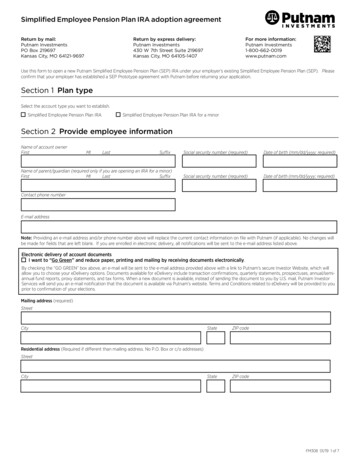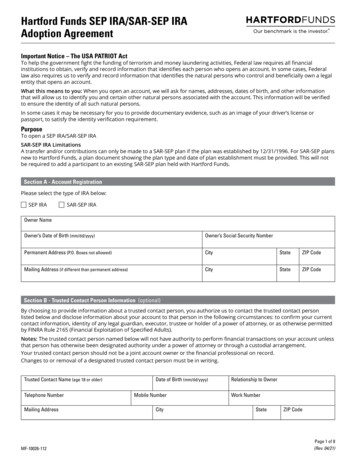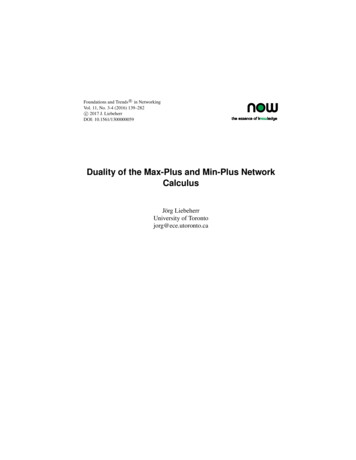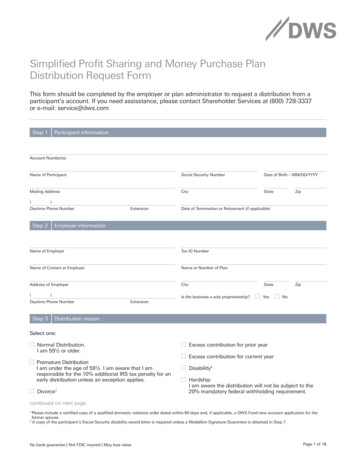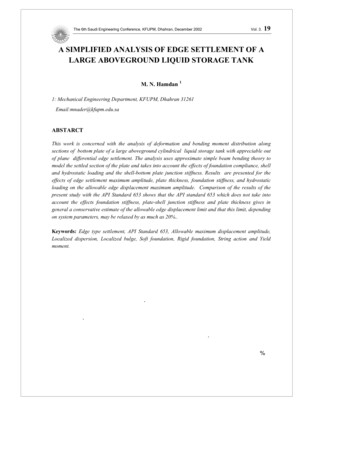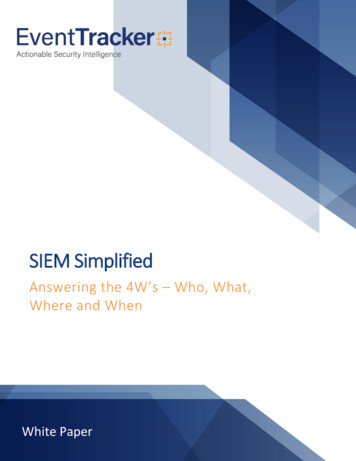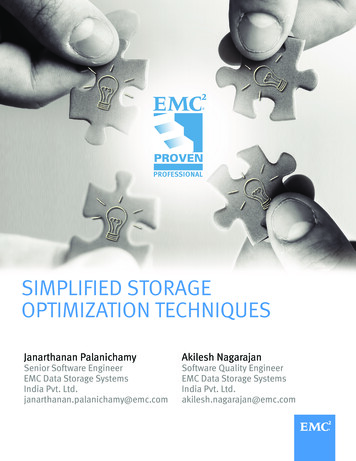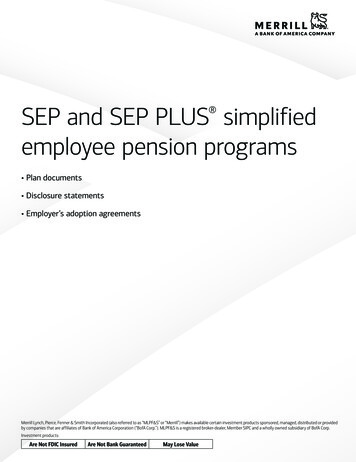
Transcription
SEP and SEP PLUS simplifiedemployee pension programs Plan documents Disclosure statements Employer’s adoption agreementsMerrill Lynch, Pierce, Fenner & Smith Incorporated (also referred to as “MLPF&S” or “Merrill”) makes available certain investment products sponsored, managed, distributed or providedby companies that are affiliates of Bank of America Corporation (“BofA Corp.”). MLPF&S is a registered broker-dealer, Member SIPC and a wholly owned subsidiary of BofA Corp.Investment products:Are Not FDIC InsuredAre Not Bank GuaranteedMay Lose Value
Table of ContentsSEP ProgramSEP PLUS ProgramThis Merrill Lynch Prototype Simplified Employee Pension Planis for use on or after January 1, 2002 and, as required by law,does not include a salary reduction feature. A second plan, theMerrill Lynch Prototype Simplified Employee Pension Plus Plan,includes a salary reduction feature and is available for useby Employers who have maintained Simplified EmployeePension Plans with salary reduction, features since, at least,December 31, 1996.This Merrill Lynch SEP Plus Prototype Simplified EmployeePension Plan includes a salary reduction feature that is intendedto qualify under Internal Revenue Code of 1986, as amended,(“Code”) section 408(k)(6) and any guidance issued thereunder.This Merrill Lynch SEP Plus Prototype Simplified EmployeePension Plan is limited to use by Employers who maintainedsimplified employee pension plans with salary reduction featureson December 31, 1996.The Merrill Lynch Prototype Simplified Employee Pension Planas set forth in this booklet has been approved by the InternalRevenue Service. Approval by the IRS, however, is a determinationas to the form, not the merits, of this prototype plan.This Merrill Lynch SEP Plus Prototype Simplified Employee PensionPlan as set forth in this booklet has been approved by the InternalRevenue Service. Approval by the IRS, however, is a determinationas to the form, not the merits, of this prototype plan.For Simplified Employee Pension Plans (without a SalaryReduction feature established or amended on or afterJanuary 1, 2002.)Retirement planning with the Merrill Lynch SEP Program . . . . . . . . 1Prototype SEP Plan. . . . . . . . . . . . . . . . . . . . . . . . . . . . . . . . . . . . . . . . . . . 1IRS approval . . . . . . . . . . . . . . . . . . . . . . . . . . . . . . . . . . . . . . . . . . . . . . . . . 5Prototype SEP disclosure statement . . . . . . . . . . . . . . . . . . . . . . . . . . . 6For Simplified Employee Pension Plans that included SalaryReduction features on December 31, 1996.Prototype SEP PLUS Plan . . . . . . . . . . . . . . . . . . . . . . . . . . . . . . . . . . . . 11IRS approval . . . . . . . . . . . . . . . . . . . . . . . . . . . . . . . . . . . . . . . . . . . . . . . . 17Prototype SEP PLUS Disclosure statement . . . . . . . . . . . . . . . . . . . 18Notice to employees . . . . . . . . . . . . . . . . . . . . . . . . . . . . . . . . . . . . . . . . 23Prototype SEP PLUS Employer’s adoption agreement . . . . . . . . . . 26Prototype SEP employer’s adoption agreement . . . . . . . . . . . . . . . . . 9Simplified Employee Pension Program/Simplified Employee Pension Program PLUSII
Retirement planning with the Merrill Lynch SEP programWhen it comes to securing your financial future, an employer-sponsored retirement plan is a tremendous benefit. With taxfavored investment vehicles playing an ever-increasing role in retirement planning, Merrill Lynch’s SEP Program is the firstchoice of many self-employed individuals and small business owners.Merrill Lynch’s SEP Program has a combination of features making it attractive to employers and employees alike. A SEPPlan permits employers to make tax-deductible contributions to SEP/IRA accounts that are maintained by employees, andallows for the tax-deferred accumulation of assets that can significantly increase the growth potential of a retirementaccount. Plan participants enjoy separate SEP/IRA accounts, giving each the opportunity to take an active part in his orher own retirement planning and to make individually appropriate investment decisions in order to secure income for acomfortable retirement.In addition, the SEP/IRA is a less complex and more economical vehicle than other tax-favored retirement plans. It can beused to receive traditional IRA contributions and rollover assets from other retirement plans. For small business owners,maintaining a SEP plan presents fewer administrative tasks and allows greater flexibility.Merrill Lynch’s SEP Program can be part of a sound retirement plan. By combining personal savings and Social Securitybenefits with a SEP/IRA account, you can plan effectively for the retirement lifestyle you want. You can gain the servicesof our professionally trained Financial Advisor, who will work with you and your plan participants to explore investmentalternatives, and you can benefit from our years of experience as a retirement plan custodian.Take your first step toward a financially secure tomorrow by planning for your employees’ and your retirement needs today.Prototype SEP PlanArticle I. Definitions“Compensation” means:As used in this Prototype SEP and Employer’s Adoption Agreement,each of the following terms shall have the meaning for that term setforth in this Article I:(a) For an Employee other than a Self-Employed Individual, wages[as defined in Code section 3401(a)] and all other payments ofcompensation by the Employer to the Employee included in the“Wages, tips, other compensation” box on the Internal RevenueService Form W-2 furnished to the Employee, which informationis required to be reported by the Employer under Code sections6041(d), 6051(a)(3) and 6052. In determining Compensation, theEmployer must include wages without regard to rules under Codesection 3401(a) that contain limitations with respect to wagesbased on the nature or location of the Employee’s employmentor services performed.“Employer’s Adoption Agreement” means a document so designatedwith respect to this Prototype SEP and executed by the Employer, asamended from time to time.“Affiliate” means any corporation or unincorporated business (otherthan the Employer): (a) which is controlled by, or under commoncontrol with, the Employer within the meaning of sections 414(b)and (c) of the Code, (b) which is a member of an “affiliated servicegroup” (as defined in section 414(m) of the Code) which includesthe Employer, or (c) which is required to be aggregated with theEmployer under section 414(o) of the Code and the regulationsthereunder provided that for purposes of Article IV, “Affiliate” statusshall be determined in accordance with section 415(h) of the Code.“Business” means in the case of an Employer that is a soleproprietorship or partnership, the trade or business of the Employerwith respect to which this Plan is adopted, and in the case ofan Employer that is a corporation, each trade or business of thecorporation.“Code” means the Internal Revenue Code of 1986, as now in effector as amended from time to time. A reference to a provision of theCode shall be to such provision and any valid regulations pertainingthereto as well as to the corresponding provision of any legislationwhich amends, supplements or supersedes that provision and anyvalid regulations pertaining thereto.(b) For a Self-Employed Individual, his or her Earned Income for thePlan Year involved.(c) For any Employee (including a Self-Employed Individual),Compensation shall include any amount which is contributedby the Employer pursuant to a salary reduction agreement andwhich is not includable in the gross income of the Employeeunder Code section 125, 402(e)(3), 402(h), 403(b), 408(p)(2)(A)(i),457, or, effective January 1, 2001, 132(f)(4).(d) For any Employee (including a Self-Employed Individual), theannual Compensation taken into account for determining allbenefits provided under the Plan for any Plan Year shall notexceed the amount specified in Code section 408(k)(3)(C) [asindexed for cost-of-living pursuant to Code section 408(k)(8)];provided, however, that the dollar increase in effect on January 1of any calendar year is effective for Plan Years beginning in suchcalendar year.Simplified Employee Pension Program/Simplified Employee Pension Program PLUS1
(e) If a determination period consists of fewer than 12 months,the foregoing annual compensation limit will be multiplied by afraction, the numerator of which is the number of months in thedetermination period, and the denominator of which is 12.(f) For the purposes of defining compensation for the compensationlimit under Code section 408(k)(2)(C), the foregoing provisions ofsubsections (a)-(e) under the term “Compensation” shall apply byvirtue of these provisions meeting the definition of compensationset forth under Code section 414(q)(4).“Defined Contribution Plan” means a plan of the type defined inCode section 414(i) maintained by the Employer or an Affiliate, asapplicable.“Earned Income” means the “net earnings from self-employment”[within the meaning of Code section 401(c)(2) but without regard toany exclusion under Code section 911] of a Self-Employed Individualfrom the Business, but only if the personal services of the SelfEmployed Individual are a material income-producing factor withrespect to the Business. Net earnings will be determined:“Employer” means the corporation, proprietorship, partnership orother organization (or any successor thereto) which adopts the Planby execution of an Employer’s Adoption Agreement. Each Affiliateshall also adopt this Plan, and each of such adopting Affiliates shallbe deemed an “Employer” with respect to the Plan; provided, that theEmployer signing the Employer’s Adoption Agreement shall (a) be thePlan sponsor within the meaning of ERISA section 3(16)(B), and (b)have the authority to act for all participating Employers with respectto Plan administration and the execution and amendment of the Plan.“Employer Contributions” means the contributions made on aParticipant’s behalf described in Article III.“ERISA” means the Employee Retirement Income Security Actof 1974, as now in effect or as amended from time to time. Areference to a provision of ERISA shall be to such provision and anyvalid regulations pertaining thereto as well as to the correspondingprovision of any legislation which amends, supplements or supersedesthat provision and any valid regulations pertaining thereto.(c) Without regard to items not included in gross income and thedeductions properly allocable to or chargeable against such itemsand are to be reduced by contributions by the Employer to aretirement plan to the extent deductible under Code section 404,“Leased Employee” means any individual (other than an Employee)who, pursuant to an agreement between the recipient Employer andany other person (the “leasing organization”), has performed servicesfor the recipient Employer [or for the recipient Employer and “relatedpersons” determined in accordance with Code section 414(n)(6)] ona substantially full-time basis for a period of at least one year, suchservices are performed under the primary direction or control of therecipient Employer and such individual is required to be treated as anEmployee under Code section 414(n), and any other individual whomust be treated as a “leased employee” under regulations adoptedpursuant to Code section 414(o).(d) with regard to the deduction allowed to the Self-EmployedIndividual by Code section 164(f); and“Participant” means an Eligible Employee who satisfies the eligibilityrequirements of Article II with respect to the Plan Year involved.(e) As if the term “trade or business” for purposes of Code section1402 included service described in Code section 1402(c)(6).“Plan” means the simplified employee pension plan of the Employerin the form of this Prototype SEP and the applicable Employer’sAdoption Agreement executed by the Employer.(a) Without regard to paragraphs (4) and (5) of Code section 1402(c),(b) In the case of any individual who is treated as an employee undersection 3121(d)(3)(A), (C),or (D), Without regard to paragraph (2) ofCode section 1402(c),“Eligible Employee” means any Employee of an Employer otherthan an Employee in either or both of the following categories ofEmployees:(b) Nonresident aliens within the meaning of Code section 7701(b)(1)(B) who receive no earned income within the meaning ofCode section 911(d)(2) from the Employer or any Affiliate whichconstitutes income from sources within the United States withinthe meaning of Code section 861(a)(3).“Plan Year” means as specified in the Employer’s Adoption Agreementeither the calendar year or the Employer’s tax year ending on thedate specified in the Employer’s Adoption Agreement. If the PlanYear is modified by an amendment to the Employer’s AdoptionAgreement, the term “Plan Year” means the Plan Year in effect priorto the amendment, the short period commencing on the first day inwhich the modification is effective and ending on the day before thefirst day of the first Plan Year as so modified, and each consecutivetwelve month period thereafter ending on the date specified in theEmployer’s Adoption Agreement. In the event of such a change inPlan Year for purposes of any service requirement specified in theEmployer’s Adoption Agreement, (a) an Employee who has any servicewith the Employer during the short period must be given credit forthat service in determining whether he or she has satisfied thatrequirement and (b) each Employee who but for such change wouldhave been entitled to a contribution for the calendar year in whichthe short period begins shall be entitled to share in any Employercontribution made pursuant to Article III for the short period.Notwithstanding the foregoing, the Employer’s Adoption Agreementmay provide for inclusion of either or both categories of Employees asEligible Employees.“Prototype SEP” means Merrill Lynch’s Prototype Simplified EmployeePension Plan as set forth in this document, as amended from timeto time.“Employee” means a Self-Employed Individual, any individual who isemployed by the Employer in the Business and any individual who isemployed by an Affiliate. Each Leased Employee shall also be treatedas an Employee of the recipient Employer.“Self-Employed Individual” means an individual who has EarnedIncome for the Plan Year involved, or who would have had such EarnedIncome but for the fact that the Business had no net earnings forthat Plan Year. Such term shall also include an individual who has(a) Employees included in a unit of Employees covered by a collectivebargaining agreement between the Employer or any Affiliateand “employee representatives,” if retirement benefits were thesubject of good faith bargaining and 2% or less of the Employeeswho are covered pursuant to that agreement are professionalemployees as defined in Treasury Regulation § 1.410(b)-9. Forthis purpose, the term “employee representatives” does notinclude any organization more than half of whose membersare Employees who are owners, officers or executives of theEmployer or any Affiliate.Simplified Employee Pension Program/Simplified Employee Pension Program PLUS2
been a self-employed individual within the meaning of the precedingsentence for any prior taxable year.of Compensation for any additional allocation (the “ExcessPercentage”) under this paragraph shall not exceed the lesser of:“SEP/IRA” means the Merrill Lynch Individual Retirement CustodialAccount established by or on behalf of an Employee for investmentof contributions made on behalf of the Employee under the Plan.(i) The contribution percentage used under paragraph 1; or(ii) The applicable percentage determined in accordance withintegration and percentages outlined in the following chart:“Taxable Wage Base” means the contribution and benefit base ineffect under section 230 of the Social Security Act at the beginningof the Plan Year involved.If the IntegrationLevel is:Article II. Eligibility to participate1) Equal to theTaxable Wage BaseEach individual who at any time during a Plan Year was an EligibleEmployee who met the eligibility and any age and/or servicerequirements set forth in the Employer’s Adoption Agreement shallbe a Participant eligible to receive an allocation to his SEP/IRA for thePlan Year and otherwise participate in the Plan. Notwithstanding theforegoing, an Employee who does not receive Compensation fromthe Employer for a Plan Year of at least the amount specified in Codesection 408(k)(2)(C), as indexed for cost-of-living pursuant to Codesection 408(k)(8), shall not be a Participant in the Plan for the Plan Year.Article III. Employer contributionsA. Allocation formula not providing for permitted disparityIf the Employer elects in the Employer’s Adoption Agreement thatEmployer Contributions are not calculated using “permitted disparity,”the Employer will decide how much, if anything, to contribute for eachPlan Year to the SEP/IRAs of Participants. The allocation will be basedon the same percentage of each Participant’s Compensation, providedthat the contribution for any Employee shall not exceed the lesser ofthe percentage of the Participant’s Compensation specified in Codesection 402(h)(2)(A) from the Employer for the Plan Year involved orthe amount specified in Code section 415(c)(1)(A), as adjusted underCode section 415(d) (or such higher amount as may be permissibleunder applicable Treasury Department regulations). For purposes ofthe limitation described in the preceding sentence, Compensationdoes not include any amount contributed by the Employer pursuant toa salary reduction agreement and which is not included in the grossincome of the Employee under Code section 125, 132(f)(4), 402(e)(3),402(h)(1)(B), 403(b), 408(p)(2)(A)(i) or 457.B. Allocation formula providing for permitted disparityIf the Employer so elects in the Employer’s Adoption Agreement,the Employer Contributions to the SEP/IRA of each Participantshall be calculated using “permitted disparity,” often referred toas the contributions being “integrated” with Social Security, in thefollowing manner:1) First the Employer will decide how much to contribute to eachParticipant’s SEP/IRA as a uniform percentage (the “BasePercentage”) of the Participant’s Compensation. The BasePercentage shall not be less than 3% unless either (a) the Planis not a “top-heavy” plan as described in Article V or (b) theEmployer has designated in the Employer’s Adoption Agreementthat “top-heavy” minimum contributions will be provided underanother Defined Contribution Plan.2) After the contribution has been allocated pursuant to the previousparagraph, an additional allocation shall be made to the SEP/IRA of each Participant, taking into consideration only thatamount of such Participant’s Compensation in excess of theIntegration Level designated by the Employer in the Employer’sAdoption Agreement for the Plan Year involved. The percentageThe applicablepercentage is:5.7%More than:But not more than:2) 020% of theTaxable Wage Base5.7%3) 20% of theTaxable Wage Base80% of theTaxable Wage Base4.3%4) 80% of theTaxable Wage BaseUp to theTaxable Wage Base5.4%For 2007, the Taxable Wage Base is 97,500. For 2008, the TaxableWage Base is 102,000.For purposes of the allocation described in the preceding chart, in noevent can the amount allocated to a Participant’s SEP/IRA exceed thelesser of the percentage of the Employee’s Compensation specifiedin Code section 402(h)(2)(A) or the amount specified in Code section415(c)(1)(A), as adjusted under Code section 415(d) (or such higheramount as may be permissible under applicable Treasury Departmentregulations). For purposes of the limitation described in the precedingsentence, Compensation does not include any amount contributed bythe Employer pursuant to a salary reduction agreement and which isnot included in the gross income of the Employee under Code section125, 132(f)(4), 402(e)(3), 402(h)(1)(B), 403(b), 408(p)(2)(A
Prototype SEP PLUS Employer s adoption agreement 26 (d) As used in this Prototype SEP and Employer’s Adoption Agreement, thereunder provided that for purposes of Article IV, “Affiliate” status . Retirement planning with the
